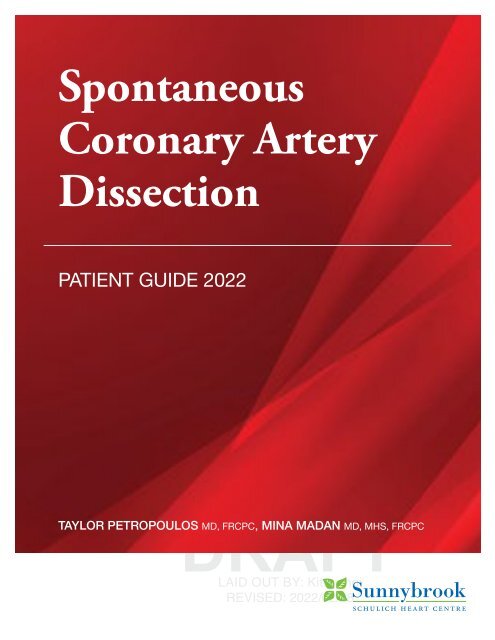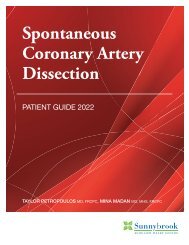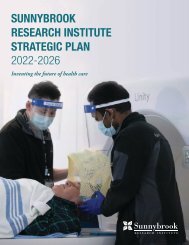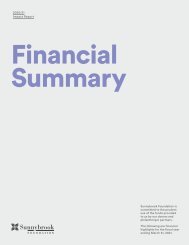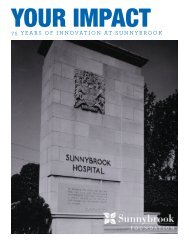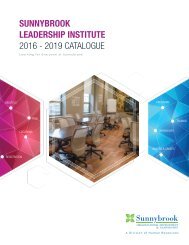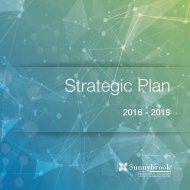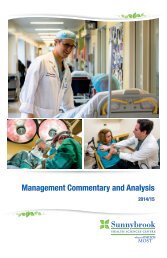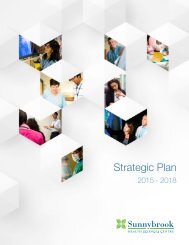Spontaneous-Coronary-Artery-Dissection
Create successful ePaper yourself
Turn your PDF publications into a flip-book with our unique Google optimized e-Paper software.
<strong>Spontaneous</strong><br />
<strong>Coronary</strong> <strong>Artery</strong><br />
<strong>Dissection</strong><br />
PATIENT GUIDE 2022<br />
TAYLOR PETROPOULOS MD, FRCPC, MINA MADAN MD, MHS, FRCPC<br />
LAID OUT BY: Kitty choi<br />
REVISED: 2022/02/28
Contents<br />
Acknowledgements..............................................................................................................................................................1<br />
Introduction.....................................................................................................................................................................................2<br />
What is spontaneous coronary artery dissection (SCAD)?...............................................3<br />
How common is SCAD?................................................................................................................................................4<br />
Who gets SCAD?....................................................................................................................................................................4<br />
What are potential causes and risk factors for SCAD?.........................................................5<br />
How are SCAD heart attacks different from regular heart attacks?......................6<br />
Signs and symptoms..........................................................................................................................................................7<br />
Diagnosis...........................................................................................................................................................................................8<br />
Acute Management..............................................................................................................................................................9<br />
What medications should I be on?...............................................................................................................11<br />
What screening should I have after a diagnosis of SCAD?..........................................14<br />
What is my risk for another SCAD related heart attack?.................................................15<br />
Pregnancy-Associated SCAD.............................................................................................................................16<br />
Living with SCAD.................................................................................................................................................................17<br />
Additional Resources.....................................................................................................................................................18<br />
When to Seek Medical Attention....................................................................................................................18<br />
Notes ..................................................................................................................................................................................................19
ERAS Acknowledgements<br />
The authors would like to pay special tribute to our patients and their families, who<br />
have taught us so much. We would like to thank the many reviewers of this guide who<br />
generously gave their time to review this guide and provided thoughtful comments and<br />
suggestions. Reviewers included Lesley Krempulec, Geraldine James, Colleen Nelson,<br />
anonymous patient reviewer, Kristen Hamilton, George Petropoulos, Katherine Farrand<br />
and Rebecca Stockford-Lehman. Thank you for helping to shape this final version.<br />
1 | SCAD Patient Guide 2022<br />
LAID OUT BY: Kitty choi<br />
REVISED: 2022/02/28
Introduction<br />
This guide is for people who have been affected with spontaneous coronary artery<br />
dissection (SCAD), their families, and anyone who wants a basic understanding of SCAD,<br />
its diagnosis, and management.<br />
This guide does not replace treatment from your doctor. It can be used as an information<br />
resource and help with any questions you may have.<br />
SCAD can be a cause of heart attacks. This guide has information on:<br />
• SCAD risk factors<br />
• Symptoms<br />
• Diagnosis<br />
• Treatment<br />
We hope this guide helps you understand SCAD.<br />
LAID OUT BY: Kitty choi<br />
REVISED: 2022/02/28<br />
SCAD Patient Guide 2022 | 2
What is spontaneous coronary artery<br />
dissection (SCAD)?<br />
<strong>Spontaneous</strong> coronary artery dissection (SCAD), is when there is a sudden tear in the wall<br />
of one or more blood vessels in the heart. This results in a buildup of blood between the<br />
layers of the artery wall. As blood collects between the layers of the wall, the vessel<br />
narrows. This impairs blood flow to the heart which causes a heart attack.<br />
Figure 1: SCAD heart attack versus traditional heart attack.<br />
3 | SCAD Patient Guide 2022<br />
LAID OUT BY: Kitty choi<br />
REVISED: 2022/02/28
How common is SCAD?<br />
SCAD makes up 4% of heart attacks across the world. In women less than or 50 years of<br />
age, SCAD is the cause of 35% of heart attacks. SCAD is the number one cause of heart<br />
attacks in pregnancy.<br />
Who gets SCAD?<br />
SCAD is most common in middle-aged women between the ages of 45 to 55. Less than<br />
10-15% of SCAD cases occur in males.<br />
LAID OUT BY: Kitty choi<br />
REVISED: 2022/02/28<br />
SCAD Patient Guide 2022 | 4
What are potential causes and risk factors<br />
for SCAD?<br />
It is unclear what causes SCAD. In more than 20% of cases there is no known cause.<br />
We do know that:<br />
• Sex: SCAD affects many more females than males.<br />
• Fibromuscular dysplasia (FMD): This is a condition with abnormal twisted blood<br />
vessels throughout the body with areas of vessel narrowing and dilation. It most<br />
commonly affects blood vessels in the heart, the head and neck, and the kidneys.<br />
This condition has been found in more than 60% of SCAD patients.<br />
• Pregnancy: SCAD can occur during and right after pregnancy. It has been shown<br />
to be more common in females who have had more than one pregnancy or births.<br />
• Emotional and physical stress: Patients with SCAD have higher rates of physical<br />
and emotional stressors (for example: loss of a loved one, a job or a relationship,<br />
work stress.).<br />
• Connective tissue disorders: This is a group of disorders involving tissue that<br />
connects structures of the body together. About 3 to 4% of SCAD is linked<br />
to underlying connective tissue disorders. These include Marfan’s syndrome,<br />
Ehlers-Danlos and Loey-Dietz syndrome.<br />
• Hormonal therapy: Although up to 10% of patients with SCAD were taking<br />
hormonal therapy, so far there is no conclusive evidence that hormonal therapy<br />
causes SCAD or increases the risk of SCAD recurrence.<br />
• Genetics: SCAD is rarely associated with a family history. Very few genes have<br />
been identified that have an association with SCAD. Some of these gene mutations<br />
are familial including F11R and TLN1. Other gene mutations are spontaneous including<br />
TSR1, PHACTR1 and EDN1. Further research is needed to help understand<br />
whether there is a genetic basis for SCAD.<br />
5 | SCAD Patient Guide 2022<br />
LAID OUT BY: Kitty choi<br />
REVISED: 2022/02/28
How are SCAD heart attacks different<br />
from regular heart attacks?<br />
Compared to regular coronary artery disease, SCAD patients have lower rates of<br />
traditional cardiovascular risk factors. SCAD patients have lower rates of high blood<br />
pressure, high cholesterol, diabetes, and smoking. Patients with SCAD report higher rates<br />
of emotional and physical stressors.<br />
Table 2: Key differences in demographics and associated conditions in SCAD<br />
compared with traditional coronary artery disease (CAD) (adapted from Adlam,<br />
García-Guimaraes, et al., 2019).<br />
Traditional Heart Attack<br />
SCAD Heart Attack<br />
Sex<br />
Age < 65 yrs + +<br />
High blood pressure + +<br />
High cholesterol + +<br />
Diabetes + -<br />
Smoking + +<br />
Pregnancy + +<br />
Emotional stress + +<br />
Strenuous exercise + +<br />
Migraines - +<br />
FMD - +<br />
Legend: Male Female<br />
LAID OUT BY: Kitty choi<br />
REVISED: 2022/02/28<br />
SCAD Patient Guide 2022 | 6
Signs and symptoms<br />
The majority of patients with SCAD have new chest pain, much like a regular heart attack.<br />
Other symptoms may include:<br />
Pain in the arms,<br />
shoulders or jaw<br />
Back pain<br />
Nausea and<br />
vomiting<br />
Sweating<br />
Shortness of<br />
breath<br />
Dizziness or<br />
light-headedness<br />
Extreme<br />
fatigue<br />
Headache<br />
Fainting<br />
Palpitations/<br />
heart racing<br />
Rarely, patients can have more severe symptoms including dangerous heart rhythms<br />
known as ventricular tachycardia and ventricular fibrillation (2-8%), cardiogenic shock<br />
(a life-threatening condition where your heart can’t pump enough blood to your organs)<br />
or sudden death.<br />
7 | SCAD Patient Guide 2022<br />
LAID OUT BY: Kitty choi<br />
REVISED: 2022/02/28
Diagnosis<br />
The first tests used to diagnose SCAD are the same as those used to diagnose traditional<br />
types of heart attacks. Patients usually have abnormal electrocardiograms (ECGs) and<br />
elevated heart blood markers, known as troponins. The best test used to diagnose SCAD<br />
is a coronary angiogram.<br />
A coronary angiogram is an imaging test during which contrast (x-ray dye) is injected into<br />
the arteries of the heart (coronary arteries) and x-ray images are used to look for artery<br />
narrowing. Classic findings on a coronary angiogram can help differentiate SCAD heart<br />
attacks from traditional heart attacks.<br />
In some cases, more imaging from within the coronary arteries is needed to help make a<br />
diagnosis of a SCAD heart attack versus a traditional heart attack. These include optical<br />
coherence tomography and intravascular ultrasound. These are performed at the same<br />
time as the coronary angiogram, if needed.<br />
Other non-invasive imaging studies such as computed tomography angiography or<br />
magnetic resonance angiography are less useful to make the initial diagnosis of SCAD,<br />
but help to screen other large blood vessels for abnormalities like FMD or aneurysms.<br />
LAID OUT BY: Kitty choi<br />
REVISED: 2022/02/28<br />
SCAD Patient Guide 2022 | 8
Management<br />
Unlike traditional heart attacks which do not get better on their own, the majority of SCAD<br />
blood vessels heal with no treatment. Studies which looked at SCAD blood vessels with<br />
a repeat coronary angiogram 30 days after the first SCAD heart attack, showed that 95%<br />
of SCAD blood vessels had healed without treatment. This is why we don’t treat most<br />
SCAD related heart attacks with invasive therapies.<br />
Although a conservative strategy is used for the majority of patients, 2-8% of patients<br />
need invasive treatment because the tear and blood build up in the affected blood vessel<br />
does not resolve on it’s own or gets worse.<br />
A few patients who do not improve without treatment or have severe SCAD heart<br />
attacks, need to have the blockage of the coronary artery fixed. This process is known<br />
as revascularization. Options for revascularization include percutaneous coronary<br />
intervention (PCI) and coronary artery bypass grafting (CABG).<br />
Percutaneous <strong>Coronary</strong> Intervention (PCI)<br />
Percutaneous coronary intervention (PCI) may be considered in patients who have a<br />
SCAD heart attack with unstable features (ongoing chest pain, unstable condition, very<br />
large heart attack) or multiple coronary arteries affected by SCAD.<br />
In these situations, the goal of PCI is to restore blood flow to the blocked SCAD blood<br />
vessel to minimize the damage to the heart. PCI uses a balloon to open the blockage<br />
in the coronary artery and possibly place a stent afterwards to keep the artery open. If<br />
needed, PCI can be performed immediately after the coronary angiogram is completed.<br />
PCI is usually a lifesaving intervention in SCAD heart attacks. Some complications of<br />
PCI include recurrent coronary artery blockages in the stent, incorrect stent size for<br />
the blood vessel and residual blockages despite stent placement. Patients who require<br />
PCI for a SCAD heart attack have a higher risk of requiring a repeat procedure for<br />
recurrent coronary artery blockages compared to patients who can be managed with a<br />
conservative strategy.<br />
9 | SCAD Patient Guide 2022<br />
LAID OUT BY: Kitty choi<br />
REVISED: 2022/02/28
<strong>Coronary</strong> <strong>Artery</strong> Bypass Grafting (CABG)<br />
<strong>Coronary</strong> artery bypass grafting (CABG) is heart surgery to restore blood flow to a<br />
blocked coronary artery. It takes a blood vessel from another part of the body (usually<br />
chest wall or leg) and attaches it to the coronary artery above and below the blockage to<br />
bypass it. This new blood vessel is known as a graft. The number of grafts you will need<br />
is dependent on the number of blockages that need to be bypassed. This procedure is<br />
performed under general anesthesia, which means you will be unconscious during the<br />
operation.<br />
A very small minority of patients with SCAD heart attacks undergo heart surgery. Patients<br />
would be considered for CABG if they have a life-threatening SCAD heart attack and<br />
PCI is not possible. Most patients who undergo CABG do well in the long term, with<br />
the highest risk occurring in the immediate period surrounding the surgery. In the long<br />
term, it is common for these grafts to become blocked in more than 60% of cases as<br />
the patient’s SCAD blood vessel heals and the grafts are no longer required to redirect<br />
blood flow. Although graft closure is a long-term risk, the initial CABG operation is usually<br />
lifesaving.<br />
Figure 2: Management of SCAD heart attacks compared with traditional heart attacks.<br />
LAID OUT BY: Kitty choi<br />
REVISED: 2022/02/28<br />
SCAD Patient Guide 2022 | 10
What medications should I be on?<br />
There are no randomized controlled trials to guide medical therapy in SCAD. A randomized<br />
controlled trial involves researchers deciding randomly as to which participants in the trial<br />
receive a new treatment and which receive a placebo, or ‘fake’ treatment. This is how we<br />
study the benefits and side effects of medications to provide evidence for their use.<br />
Some commonly prescribed medications include the following:<br />
• Antiplatelet agents: These are mild blood thinners that stop cells in the blood<br />
(platelets) from sticking together and forming a clot. There is a lack of evidence<br />
to guide the duration of antiplatelet therapy and the number of antiplatelet<br />
medications to be used.<br />
» Single antiplatelet therapy refers to treatment with one antiplatelet medication,<br />
usually low dose aspirin.<br />
» Dual antiplatelet therapy refers to low dose aspirin plus a second antiplatelet<br />
agent which may be clopidogrel (Plavix), ticagrelor (Brilinta) or prasugrel (Effient).<br />
» If a stent was placed, dual antiplatelet therapy is generally recommended for<br />
1 year.<br />
» If there is no stent used the use of single versus dual antiplatelet therapy is<br />
controversial. Currently, many centers prefer the use of a single antiplatelet<br />
medication (aspirin) while some recommend that patients are treated with dual<br />
antiplatelet therapy<br />
• Beta-blockers: These are medications that slow your heart rate and may reduced<br />
the force that the blood vessels experience by the blood being pumped through.<br />
Only one study has shown benefit with beta-blocker use in SCAD patients. This<br />
study showed a lower rate of recurrent SCAD heart attacks in patients who took<br />
beta-blockers<br />
11 | SCAD Patient Guide 2022<br />
LAID OUT BY: Kitty choi<br />
REVISED: 2022/02/28
• Anti-hypertensives: These are medications that aim to lower your blood pressure.<br />
It includes a wide variety of medications such as angiotensin-converting enzyme<br />
inhibitors (ACE inhibitors), angiotensin II receptor blockers (ARBs), calcium channel<br />
blockers (CCBs) and nitroglycerin among other classes. One study showed that<br />
high blood pressure was associated with a higher risk of recurrent SCAD heart<br />
attacks and therefore recommended the use of anti-hypertensive medications to<br />
treat high blood There is no evidence that these medications have direct benefit in<br />
SCAD, however they may be used as an antihypertensive to lower blood pressure.<br />
» Angiotensin-Converting Enzyme (ACE) Inhibitors: These medications relax (dilate)<br />
the blood vessels and decrease the blood volume to lower blood pressure.<br />
» Angiotensin II Receptor Blockers (ARBs): These medications are similar to ACE<br />
inhibitors. They relax (dilate) the blood vessels and lower blood pressure.<br />
» Calcium-channel blockers (CCBs): These medications lower blood pressure by<br />
preventing calcium from entering the cells of your heart and arteries.<br />
» Nitroglycerin: This medication lowers blood pressure by relaxing (dilating) blood<br />
vessels, and may also help with symptoms of chest pain after SCAD, which is<br />
not so uncommon.<br />
There are some situations where medications should be used. These include if the<br />
patient underwent PCI or if the patient has a weak heart, also known as left ventricular<br />
dysfunction or heart failure. In these situations, medical therapy would often include the<br />
following:<br />
• Percutaneous coronary intervention (PCI): Dual antiplatelet therapy for at least one<br />
year. This includes aspirin plus a second antiplatelet either clopidogrel (Plavix),<br />
ticagrelor (Brilinta) or prasugrel (Effient).<br />
• Left ventricular dysfunction: Medical therapy is based on the heart failure guidelines.<br />
It often includes sacubitril/valsartan (Entresto), an ACE inhibitor or ARB as well as a<br />
beta-blocker, a mineralocorticoid receptor antagonist and an SGLT-2 inhibitor.<br />
Medications that should be avoided in SCAD, if possible, include triptans such as<br />
sumatriptan used for migraines, stimulants such as ADHD medications or cocaine, and<br />
hormonal therapy. The use of these medications after SCAD should be discussed with<br />
your doctors.<br />
LAID OUT BY: Kitty choi<br />
REVISED: 2022/02/28<br />
SCAD Patient Guide 2022 | 12
Table 3: Key differences in the treatment of SCAD heart attacks compared with<br />
traditional heart attacks.<br />
SCAD Heart Attacks<br />
Traditional Heart Attacks<br />
Revascularization<br />
PCI<br />
(balloon angioplasty<br />
± stenting)<br />
Conservative strategy.<br />
May consider PCI if large or<br />
unstable SCAD heart attack<br />
or multiple coronary arteries<br />
with SCAD<br />
Recommended<br />
CABG When PCI is not possible When PCI is not possible<br />
Medical Therapy<br />
Antiplatelets<br />
Lack of evidence to guide<br />
therapy.<br />
Dual antiplatelet therapy for<br />
1 year if a stent is placed.<br />
In the absence of stent<br />
implantation, use of single<br />
versus dual antiplatelet<br />
therapy is controversial<br />
Dual antiplatelet therapy<br />
for 1 year<br />
Beta-Blockers Recommended Recommended<br />
ACE Inhibitors No clear benefit Recommended<br />
ARBs No clear benefit Recommended<br />
Statins No clear benefit Recommended<br />
Lifestyle<br />
Diet No restrictions Healthy heart diet<br />
Physical activity Moderate intensity exercise Exercise intensity as<br />
tolerated<br />
Stress Management Recommended Recommended<br />
Smoking Cessation Recommended Recommended<br />
Additional Screening<br />
FMD Screening<br />
13 | SCAD Patient Guide 2022<br />
CTA from head to pelvis<br />
recommended<br />
LAID OUT BY: Kitty choi<br />
REVISED: 2022/02/28<br />
Not required
What screening should I have after<br />
a diagnosis of SCAD?<br />
Abnormalities of the arteries throughout the body are common among SCAD patients,<br />
and a condition known as fibromuscular dysplasia (FMD) has been seen in more than<br />
60% of patients.<br />
Fibromuscular dysplasia is a condition that weakens the artery walls making them<br />
prone to tears or bulging. In FMD, patients can have abnormal blood vessels in many<br />
parts of the body, including the heart, head and neck, and kidneys. It is recommended<br />
that all patients with SCAD undergo blood vessel imaging from their head to pelvis to<br />
screen for findings consistent with FMD at the time of diagnosis. This is done using noninvasive<br />
imaging such as computed tomography angiography (CTA). If a patient has<br />
FMD they should have a follow up at least once a year. Follow-up may include clinical<br />
assessment, blood work and imaging. The timing and nature of imaging however, should<br />
be individualized according to the severity of the disease and any symptoms.<br />
There is no commercially available genetic screening test for SCAD, however this is an<br />
active area of ongoing research.<br />
Screening for connective tissue diseases including Marfan syndrome, Ehlers-Danlos<br />
syndrome and Loey-Dietz syndrome, may be considered if you have other clinical signs or<br />
symptoms consistent with these conditions.<br />
Overall, we do not screen everyone for these conditions as they are rare. There is no<br />
recommended screening for autoimmune or inflammatory disorders as there is no clear<br />
association. Genetic counseling may be considered if there is a family history of inherited<br />
arteriopathy such as Marfan syndrome or a history of aneurysms.<br />
LAID OUT BY: Kitty choi<br />
REVISED: 2022/02/28<br />
SCAD Patient Guide 2022 | 14
What is my risk for another SCAD related<br />
heart attack?<br />
Recurrent SCAD heart attacks have been reported to occur in approximately 10 to 30%<br />
of patients within 3 years of their initial SCAD heart attack. As we continue to follow more<br />
SCAD patients for longer periods of time, we will learn more about the chances of another<br />
SCAD heart attack. A higher risk of SCAD recurrence is associated with severe coronary<br />
artery twisting (tortuosity), FMD with migraines and high blood pressure.<br />
To lower the risk of another SCAD event, you can maintain a healthy blood pressure, take<br />
medications to lower the shear stress on your blood vessels (beta-blockers) and maintain<br />
a healthy lifestyle that includes moderate intensity exercise.<br />
Up to 50% of patients with SCAD have recurrent chest pains after their event, even<br />
though the artery is healed in most cases. In most patients these symptoms will get<br />
better over time, however sometimes hospital admission is necessary to assess for SCAD<br />
recurrence. If you develop recurrent symptoms, speak to your doctor, who can then<br />
decide what testing and treatment you may need for chest pain after SCAD.<br />
15 | SCAD Patient Guide 2022<br />
LAID OUT BY: Kitty choi<br />
REVISED: 2022/02/28
Pregnancy-Associated SCAD<br />
Pregnancy-associated SCAD heart attacks account for less than 5-17% of SCAD cases<br />
and 1.81 per 100,000 pregnancies. SCAD can occur at anytime during or after pregnancy,<br />
however more than 70% of cases occur post-partum with the majority within the first<br />
week. Patients who develop SCAD during pregnancy tend to be much sicker with larger<br />
sized heart attacks or more than one coronary artery affected with SCAD.<br />
It is recommended that all patients who have had SCAD should avoid pregnancy due<br />
to the high risk of recurrent SCAD heart attacks. Approximately 20% of patients have<br />
recurrent SCAD heart attacks with pregnancy. Patients with SCAD should consider<br />
permanent solutions to avoid future pregnancies or consider taking contraception. It<br />
is recommended that SCAD patients avoid estrogen containing contraception options<br />
and instead used long acting progesterone only methods including the subdermal<br />
levonorgestrel implant and the levonorgestrel-releasing IUD.<br />
LAID OUT BY: Kitty choi<br />
REVISED: 2022/02/28<br />
SCAD Patient Guide 2022 | 16
Living with SCAD<br />
• Physical Activity: SCAD symptoms have been associated with physical activity in<br />
32% of patients. There are no strict recommendations to guide physical activity in<br />
SCAD patients. Physical activity recommendations should be individualized and<br />
take into consideration the patient’s baseline physical activity and fitness level.<br />
» Regular moderate-intensity exercise likely outweighs the theoretical risk of<br />
recurrent SCAD. Strenuous exercise and straining associated with heavy lifting<br />
can result in a sudden increase in your blood pressure and stress on your blood<br />
vessels causing recurrent SCAD. It is recommended that patients avoid lifting<br />
or carrying heavy objects that require prolonged straining, extreme endurance<br />
training and elite competitive sports.<br />
• Mental Health: Many SCAD patients find it hard to adjust to a new diagnosis of<br />
‘heart attack’. SCAD often happens to younger people, in their early to mid-career,<br />
and for some women during their childbearing years, or while raising a young family.<br />
High rates of anxiety (41%), depression (32%), and posttraumatic stress disorder<br />
(28%) have been reported among SCAD patients. The prevalence of anxiety<br />
diminishes over time, but posttraumatic stress disorder (PTSD) and depression<br />
remained time independent. We recommend seeking support from a mental health<br />
professional, to help manage these symptoms, as needed.<br />
• Smoking: Quitting smoking is recommended to protect your heart and<br />
cardiovascular system.<br />
• Diet: There is no known association between diet and SCAD. It is recommended<br />
that patients avoid excess caffeine and caffeinated energy drinks.<br />
• Driving: The Ontario Ministry of Transportation does not allow a person to drive<br />
after a heart attack for a minimum of one month for private driving and three<br />
months for commercial driving. Fitness to drive depends on many factors including<br />
the amount of heart damage and other medical conditions. You should discuss with<br />
your cardiologist when it is safe for you to drive again.<br />
• Sexual Activity: Most people can return to sexual activity four to six weeks after a<br />
heart attack. Speak with your doctor about when it would be safe for you to resume<br />
sexual activity.<br />
17 | SCAD Patient Guide 2022<br />
LAID OUT BY: Kitty choi<br />
REVISED: 2022/02/28
• Cardiac Rehabilitation: Cardiac rehabilitation is a program of exercise, education<br />
and counselling designed to help you recover after a heart attack in a safe<br />
environment. This personalized program will help you regain your strength and<br />
reduce your risk of having heart problems in the future. Your rehabilitation team<br />
may include a physician, nurse, occupational therapist, physiotherapist, physical<br />
educator, dietician, psychologist or psychiatrist, and social worker. It has been<br />
reported that women are only half as likely as men to attend and follow a<br />
rehabilitation program due to a variety of reasons. Take an active role in your<br />
recovery and speak to your doctor about cardiac rehabilitation options.<br />
Additional Resources<br />
• Your Cardiologist<br />
• The SCAD Alliance: https://www.scadalliance.org/<br />
• The Heart and Stroke Foundation: https://www.heartandstroke.ca/heart/conditions/<br />
spontaneous-coronary-artery-dissection<br />
• Fibromuscular Dysplasia Society of America: https://www.fmdsa.org/<br />
• FMD: https://my.clevelandclinic.org/health/diseases/17001-fibromuscular-dysplasia-fmd<br />
When to Seek Medical Attention<br />
Signs of a heart attack may include:<br />
• Chest discomfort<br />
• Upper body discomfort<br />
• Sweating<br />
• Nausea<br />
• Shortness of breath<br />
• Light-headedness<br />
If you have any of these signs, LAID call OUT 9-1-1 BY: immediately. Kitty choi<br />
REVISED: 2022/02/28<br />
SCAD Patient Guide 2022 | 18
Notes:<br />
LAID OUT BY: Kitty choi<br />
REVISED: 2022/02/28<br />
19 | SCAD Patient Guide 2022
Notes:<br />
LAID OUT BY: Kitty choi<br />
REVISED: 2022/02/28<br />
SCAD Patient Guide 2022 | 20
MADE WITH<br />
PATIENT & FAMILY<br />
INPUT<br />
PR xxxxx (2022/02/23)<br />
Schulich Heart Centre<br />
2075 Bayview Avenue<br />
Toronto, ON M4N 3M5<br />
sunnybrook.ca/heart<br />
Fully affiliated with the University of Toronto<br />
LAID OUT BY: Kitty choi<br />
REVISED: 2022/02/28


